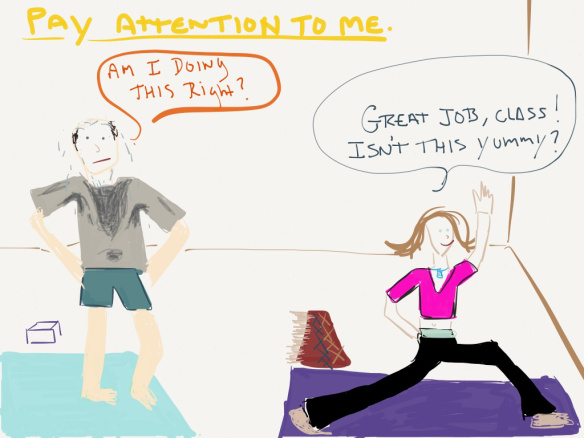|
Did you know that yoga is an unregulated profession in the US? That means that yoga teachers probably took some kind of teacher training course, but there's no way to know what (if anything) they learned.
I have a friend who graduated from a chain studio teacher training. Let's call it Pore Cower. She added up all her hours of actual class time, and her 200 hour was comprised of 90 hours of lessons and the balance, 110 hours, was taking classes. She said their anatomy was a weekend that was so boring that she took almost nothing from it at all. It's true - I loved my 200 hour, but the anatomy I got from it was coloring in what seemed to be totally random pages from an anatomy coloring book and turning them in, never to see them or talk about them again. It was worse than useless. I could have spent my coloring time actually learning something. Or sleeping. I started teaching a course for other yoga teachers when I realized that my colleagues didn't understand what tendons or ligaments were or even how muscles work. How are they supposed to help students to protect the integrity of their joints if they don't understand how joints work? Or even how many bones are involved? I could go on and on... There's more to a yoga class than the physical movement, but let's be honest - most of a yoga class is made up of physical movements. The little talks at the beginning and end are maybe a big reason why we choose yoga over something else, but all the rest is really important, too. Yoga is not a magical fairy-exercise that causes no injury. It's NOT! I promise - science promises! You can get very injured by repeatedly doing poses in a sub-optimal way. Hip and shoulder replacements, chronic knee injuries and all sorts of arthritis are becoming very common in the yoga world, and researchers can show us exactly why. So what do you do? 1) Learn to REALLY listen to your body. I had been so conditioned to believe that the light pain or discomfort I was feeling in many poses and stretches were a sign that I was doing it right. Now I know, those sensations were telling me to back off, that my connective tissue was being stretched (bad) and my bones were rubbing together (so bad!). It has taken me years to start to learn to listen to my body, and to back off when something feels even a little bad, because a little bad a few times a week over the course of years leads to something really bad, like arthritis. 2) Don't trust teachers blindly. They might not know much more than you do. They could even know less about anatomy and functional movement. We're not doctors, and for those of us who make a living doing this, teaching group classes in studios and gyms, we are probably not making enough money to really dedicate our time to researching all the new studies and information out there. Try asking your teaching if they have read any good studies or books lately or taken any continuing ed. If they are studying, great! If they are studying the physical practice from a scientific perspective with respected teachers, please send me their names. :) I'd love to take their classes! 3) Let go of the competition. Push yourself, but not to win. There's no loser in yoga - only winners, as cheesy as that sounds. 4) Have realistic expectations. Yoga can help you with strength, flexibility, balance and equanimity. It won't cause you to lose or gain a significant amount of weight. It won't cause miracles in your life. It won't cure diseases. But it can be part of a holistic approach to healing mind, body and spirit. It can make you feel amazing and help you find community. It can inspire you and give you a sense of peace. It can't reverse your male pattern baldness and it can't make your lost love come back. But it can show you how to be you, proudly and courageously, through good times and hard times. (The drawing at the top of the page is from this website https://robcomplains.com/2013/01/16/9-rules-every-yoga-teacher-should-follow/#comment-14984 and the rest of the page is even more hilarious than this one.)
2 Comments
Last week I was teaching an early morning yoga class for a convention at the Colorado Convention Center. When I arrived, the room we were supposed to be using was already set up for the day's events, so we were moved to the big lobby between the ballrooms. It was not ideal, as the staff was hurriedly setting up for the day all around us, but it was kind of funny to catch snippets of very private conversations being shouted as people went about their work, oblivious to the group of meditative yogis, or to shout "let your mind focus on your breath" over what sounded like someone emptying a huge box of silverware all over the floor. Then they started to set up the breakfast buffet about 4 feet from us. First came the fruit and bagels, the pastries and cereal. Then coffee - I saw a few students look up longingly as the aroma made it's way to us. Then they brought out trays and trays of bacon. Now, I've never liked bacon very much, so when I smelled it, I though, "Ew, how are they supposed to practice now? It smells so gross..." Then I noticed the looks on their faces. They were tortured by the bacon in a very different way than I was. I saw people swallowing hard, inhaling as though if they sniffed hard enough, they might get some bacon into their mouths somehow. We made it to the end of the class, and several of the students told me they knew it was a good class because they didn't abandon their mats to get a plateful of bacon. Compliments come in a many forms, especially to vegan chef yoga teachers. As you go through your next practice, notice if there's somewhere else you'd really rather be. If there is, maybe allow yourself to go with it, to leave your mat. But if there isn't, find the joy in being exactly where you want to be. |
AuthorAmanda has been teaching yoga and working as a vegan chef for over 10 years. Archives
August 2017
Categories |



 RSS Feed
RSS Feed
